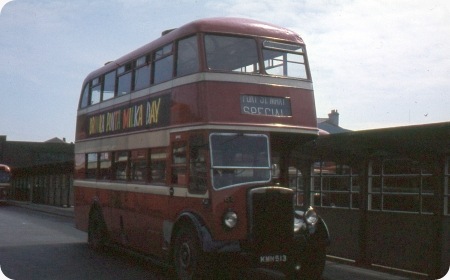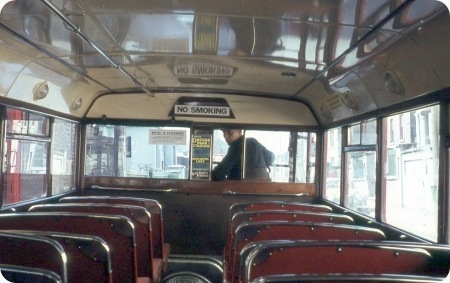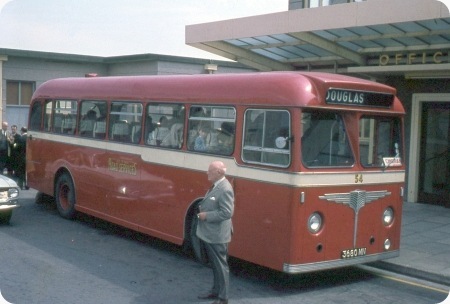

Copyright M Bishop
Isle of Man Road Services Ltd
1950
Leyland Titan PD2/1
Leyland H30/26R
I received the above two photographs along with a shot of a Tiger Cub from Michael Bishop with the
following:-
“I was on the Isle of Man to explore the railways, but found the IOMR had just closed! Lord Ailsa
came along the following year, which is why there is still something left. Another reason for going
everywhere by bus. So I’m afraid I know nothing about buses, although I remember the bus I took the
interior shot of made a lovely noise. It seems to have LEYLAND on the gearbox(?) casing. So I cannot
tell you more about them. The bus was at Peel and taken on 28.5.66.”
‘Not knowing anything about buses’ in my opinion isn’t a good enough reason for not showing an internal
shot of such a classic vehicle.
Photograph and Copy contributed by Michael Bishop
———
15/05/12 - 18:06
Don’t come much better than all Leyland PD2s, but can anyone explain why Isle
of Man always had these peculiar off balance upper deck ventilators (ONLY on the near-side)?
David Oldfield
———
16/05/12 - 07:51
I never understood that either, but it did make the IOMRS fleet rather
distinctive. (I have a feeling I have seen a photo of a similarly equipped PD2 with another
operator, but I can’t remember where or with whom). Very nice to see that tidy interior shot too. It
reminds me of Barton’s second hand no. 754 (GUT 455) ex-Allens, Mountsorrel, which operated
regularly in the early 60s on our route 15 (Ilkeston - Long Eaton - Sawley).
Stephen Ford
———
16/05/12 - 07:52
Not sure why this style was followed but Widnes also did the same thing on
their vehicles
Chris Hough
———
16/05/12 - 07:52
Widnes Corporation used the same arrangement which I can only assume was to
give upper-deck passengers a choice of the fresh-air treatment by sitting on the nearside or for the
more delicate a chance to keep out of the draught by sitting on the offside.
I don’t recall
the arrangement being used by any other operators and it certainly spoiled the appearance of the
vehicles.
I would be interested to learn if my assumption is correct.
Philip Halstead
———
16/05/12 - 08:58
Just clutching at straws, but I wonder if the odd window arrangement could
possibly be to avoid a direct "wind tunnel" effect from the offside windscreen and down
the staircase, to escape from the platform.
Chris Youhill
———
17/05/12 - 08:40
Having lived in Widnes in the 70s, Widnes Corporation were not doing their
passengers any favours with all the chemical factories in the area!
Jim Hepburn
———
30/06/12 - 11:26
As far as I know it was to do with cost - IoMRS were not known for spending
anymore than was absolutely necessary, the same window arrangement continued right through until the
last new d/d purchases in 1964, a one pane window was cheaper than an opening hopper or slider.
Equally saloon heaters were largely not provided, nor were grabrails. Whilst I can’t just recall the
grabrail specification on the PD2 shown, other than what is visible on the image, the 1964 batch of
PD3s had head height rails only installed above the two lower deck side seats, whilst the sole
upright rail, other than on the platform area, was at the top of the stairs. No other grabrails were
fitted, which meant conducting - or alighting - the bus whilst on the move
err…interesting.
busbus
———
21/08/12 - 07:37
I remember the arrival of this and its 17 sisters in 1949, and worked on them
as a seasonal conductor 1958-61. I can confirm the Company sought economy in everything; none of its
buses had direction indicators, relying instead on a white band on the right sleeve of drivers’
uniforms when stuck out of the cab window. Drivers claimed that when Leyland staff received an order
for buses "without this, without that or the other" they would say "It’s that b*****
IOM Road Services again". Due to lack of grab rails, on a lively journey I used to press the
flat of my hand against the ceiling to keep upright.
Mike Jones
———
03/01/13 - 06:34
Nice to see this pic. I’m currently working on similar bus KMN 501 but will
restoring it as Liverpool L428 JKB 580.
Rob
———
03/01/13 - 10:45
North Western was another all Leyland PD2 operator with the same ventilation
arrangement. The standard Colin Bailey body throughout its life and various modifications was
offered as standard with solid front upper deck windows, the opening vents could be specified as an
extra. Many operators bought the standard package but some quickly received complaints of lack of
ventilation, especially in the summer when tobacco smoke would add to warmth and the side window
ventilators removed little of the fug. They then retrofitted one or two vents.
North Western’s
examples were lowbridge bodies which made the problem worse and they quickly fitted a nearside vent
window, in their case the reason for the location being the offside was occupied by the
gangway.
Phil Blinkhorn



